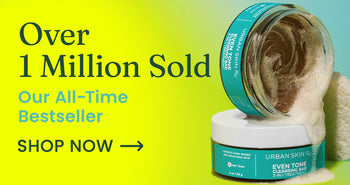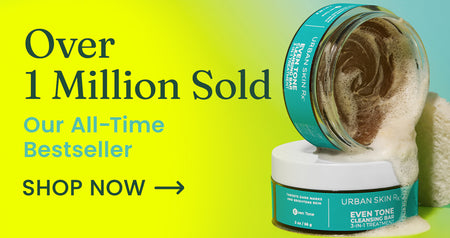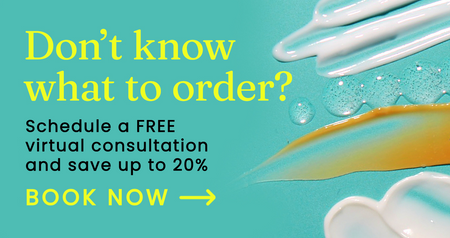Here’s How To Finally Get Rid of Body Acne

Acne and breakouts become part of your life in your teen years. Those memories of desperately covering up a smattering of blemishes with a cakey drugstore foundation before a school dance are yours to cherish even as you find relief from your wildly vacillating hormones when you get into your twenties, and your acne hopefully calms down as a result.
But even if you’re past the days of constant pimples and redness, acne and breakouts unfortunately can still happen.
Sometimes it’s because of your environment, a result of dead skin cells, a change in your skincare routine, sweat during workouts and sometimes it’s just a change in hormones. But whatever the cause, very few of us will know a life without the occasional pimple. And while information about how to handle acne on your face is legion, we don’t often talk about body acne and how it affects us.
While you may have your routine down pat for when you get a pimple on your nose, you may not quite know what to do if you notice the occasional patch of whiteheads or blackheads on your chest, back or even on your bum.
Especially in the summer when you want to get as much time in the sun as possible and show off your favorite dresses and shorts, it can be a real day-ruiner to realize you’ve broken out on some part of your body. Or worse — the night of a hot date, you’ve just gotten out of the shower and are about to start your usual moisturizing and preening, and… bam—breakout city, population: you.
If you struggle with recurring body acne, AKA bacne, and want to get it under control, or even if you just get the occasional breakout you want to know how to deal with it as quickly as possible, there are steps you can take to help improve the appearance of breakouts once they happen and, more importantly, help make sure that they don’t happen again.
What Causes Body Acne?
Several things can cause body acne, and many of them are very similar to the things that cause acne on your face because it’s all effectively the same thing.
However, sometimes body acne isn’t body acne at all. It’s something called folliculitis. Folliculitis often presents super similarly to your normal breakouts.
But rather than being blocked pores or pustules, folliculitis is actually irritation of the hair follicles. It can, however, cause pustules or red bumps — but again, it’s formed around a blocked hair follicle rather than around a pore as with acne. Folliculitis is more common on your back and chest than in other areas.
If you’re not sure whether you’re struggling with folliculitis — or if you’ve been treating your body breakouts like acne and it isn’t working — your best course of action is to speak with your doctor or dermatologist to get a professional opinion so you can be sure you’re treating the right problem.
If your body breakout is due to acne, as we said, it’s caused by a lot of the same things as acne that appears on your face. As you learned from your teenage breakouts, acne is often caused by hormonal changes.
If you’re past puberty and are wondering how that could be the case, changes in your hormone levels could be caused by anything from birth control to your period, pregnancy to menopause, chronic conditions and stress that affect your hormone levels.
If you don’t notice acne on your face but still break out on your body, it could be due to something environmental rather than hormonal. This could be a body wash, lotion, soap, body spray, body scrub or even something like laundry detergent.
As a rule of thumb, if you think your skin is reacting to a product, looking into any unnecessarily scented products first is a good bet. Or if you’ve recently switched to a new detergent or body product, it’s worth taking a break from it and going back to what you used previously to see if your skin has just become sensitized by an abrasive product.
How To Get Rid of Body Acne
Now that you hopefully have a better idea of what may be causing your body acne, let’s talk about how to get rid of it, so you have one less reason to dread bikini season when it eventually comes back around. In general, treating body acne isn’t wildly different from treating acne on your face.
Shower Daily
Hopefully, this is already part of your routine, especially if you work out regularly! But if you don’t shower daily, or you live somewhere with hard water, and you’re trying to protect your hair, you’re going to want to start as long as you’re trying to get rid of your body acne.
Washing your face twice a day and making sure you’re cleaning your body regularly to get rid of any dirt, bacteria and grime that may be hiding out in your pores and causing your breakouts is crucial.
Now, unless you’re one of those super zen people who somehow manage to take cold showers, this is going to seem like a wild recommendation. But at the end of your shower, it might help by turning the hot water off and standing under the stream of cold water for a few minutes before you get out. This will help your pores constrict and close, so they’re less susceptible to holding onto the sort of nasties that cause pimples to form.
Use the Right Shower Products
Not all bath and shower products are made equally! While you might love the scent of your shower gel, that isn’t the best barometer for whether or not it’s going to help with your body acne.
In fact, a scented body wash may actually be irritating your skin with harsh additives or alcohol, so it’s worth reading through the ingredients quickly to make sure you’re not doing more harm than good.
Instead of going for whatever smells the best, consider a body wash with Alpha Hydroxy Acids or Beta Hydroxy Acids. AHAs and BHAs are both considered chemical exfoliators, which means they help break down the bonds between the layers of your skin and help to resurface your skin.
They’re key when it comes to reducing the appearance of redness or unevenness in your complexion. If you’ve had acne on your face, you’ve probably used an AHA or BHA like Salicylic Acid or Lactic Acid to treat it.
Our Clear and Even Tone Body Cleansing Bar is made with Lactic Acid to help exfoliate the dead skin away and help to even out your skin if it’s prone to breakouts. It might seem strange at first to have skincare products for your body if the most care you’ve ever given the rest of your skin is regular moisturizing, but once your breakouts improve, you’ll never go back. The skin is, after all, the largest organ we have — it’s important to take care of it!
In addition to working chemical exfoliators into your routine, physical exfoliants are also key to helping get your acne under control. Try our Clear and Even Tone Body Cleansing Bar & Exfoliating Pouch so that you can slough off dead skin while you’re cleansing your body.
Moisturize, But Don’t Overdo It
Because we often think of acne as being caused by an overproduction of oil, there can be the temptation to try to allow your skin to dry out. But especially if you’re using products with blemish-fighting ingredients like AHAs and BHAs, it’s important to moisturize because these ingredients can be drying in and of themselves.
While you do want to try to balance out your skin’s oil production, if that’s part of your problem, drying out your skin too much can actually lead to an overproduction of oil to compensate, which only makes the potential for breakouts worse!
After you shower, you’ll want to moisturize your whole body but keep the moisturizer light. It’s ideal if you can find a moisturizer that’s formulated to keep your skin hydrated but not oily.
Serums Aren’t Just For Your Face
Much like with your bath products, buying a serum or spot treatment for your body might be new to you. But if you’re looking to stop your body from breaking out, it really is a great idea!
Ingredients like Glycolic Acid, Niacinamide, and even Retinol are great additives to look for. You want something that will help even out your complexion, refresh your skin and pores and help control any overproduction of oil you may be experiencing.
As long as your blemishes aren’t in a sensitive area, you can probably feel free to use your favorite spot treatment on your body as well as your face. At the end of the day, skin is skin! So while products specifically formulated to treat breakouts on your body are great and may be more effective on the whole, there isn’t any reason if you have products or routines that work for your face that you can’t use them on your body too.
Let Your Body Breathe
As frustrating as it may be if all you want to do is cover up during a body breakout, it’s important to let your skin breathe. This is the main difference between treating acne on your face and body. With few exceptions, your face is always exposed to the air — not so with your body.
Wear loser clothes, like breezy skirts and dresses or wide-legged trousers, and leave your leggings and tights in the drawer until your blemishes clear up. If you’re going to wear a comfy but scratchy wool sweater, just layer up with a t-shirt underneath, so your skin has some space. You don’t want to wipe off any products you’ve used onto your clothes, and you also don’t want to cause additional irritation to your skin when it’s trying to heal.
In Conclusion
Treating body acne can seem daunting, but it’s actually not much different from getting rid of the blemishes you get on your face.
And while it’s one hundred times more enraging when you realize despite your perfectly clear facial complexion, you’re sporting an angry cluster of pimples on your rear; now you’re equipped with everything you need to know as far as how to get rid of body acne goes. Hello, swimsuit season — how we’ve missed you.
Service Representative




